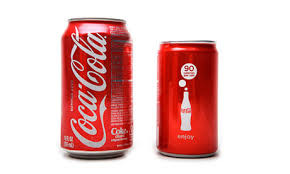
Both Coke and Pepsi, the largest of the carbonated drinks purveyors, now offer smaller cans and bottles of product – and charge more for them. The smaller containers have fewer calories, hence less guilt for the guzzlers. But the price is steep. You won’t be saving any money by purchasing the mini cans.The smaller containers can cost twice as much per ounce as standard cans and bottles.
The 7.5-ounce mini-cans and 8-ounce or 8.5-ounce bottles have been around for awhile, but the soda giants are hyping them to ride the health-concern crest. Last year, Coke reported sales of a million mini-cans.
The shift is an about-face for the producers, who have in the past measured the volume of product sold. But they see an opportunity to give the soda drinkers alternatives while health officials are blaming their products for a role in the national epidemic of obesity, especially among children.
When soda sales reached their peak in 1998, the average American was drinking the equivalent of 576 cans a year. By 2013, that average had slipped to 450 cans a year. The smaller containers appeared to the producers a good alternative to seeing sales continue to slip. It fits into the current philosophy of smaller portions of all edibles.
So while the cans get smaller, the price tag gets larger. A regular 12-ounce can of Coke sells, on average, for 31 cents. The 7.5-ounce mini-can one shelf over carries a price of 40 cents each. That means the purchaser is paying 2.6 cents per ounce for the larger version, 5.3 cents per ounce for the cute little can. The result is increased revenue for the producers. Sales indicate that many soda fans are willing to pay the difference. The company’s sales for the smaller versions were up 9 percent through last October, while the old standard sizes only saw an 0.1 percent hike.
Still, the old standbys dominate the industry and nobody knows how long the yen for smaller servings will last.
Coke is hedging its bets with other products that cater to more health-conscious Americans, such as a reduced-calorie drink sweetened with a mix of sugar and stevia, a sugar substitute.
The whole “smaller is better” scenario is a direct about-face after years of increasing the size of soda pop servings. Until 1955, the standard 6.5-ounce bottle was the most frequently sold serving. Then came larger and larger containers, up to and including the three-liter plastic bottle. At the fountain, the availability of 32- and even 64-ounce cups fed the craze.
When it became apparent that all those big gulps of soda were contributing to poor health habits, officialdom began taking steps. In Berkeley, Calif., voters approved a per-ounce tax on the drinks. It seemed prudent for the Coke and Pepsi people to join the crusade for fewer calories. Last fall, the two producers were joined by Dr. Pepper in supporting an initiative to reduce the calories in their drinks by 20 percent over the next decade. Smaller-sized servings will be part of that campaign.